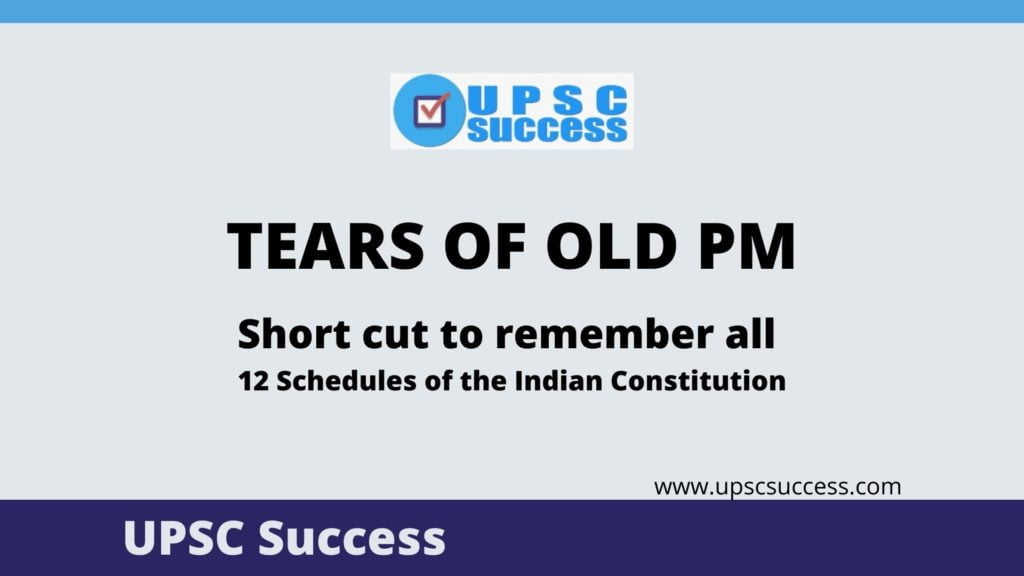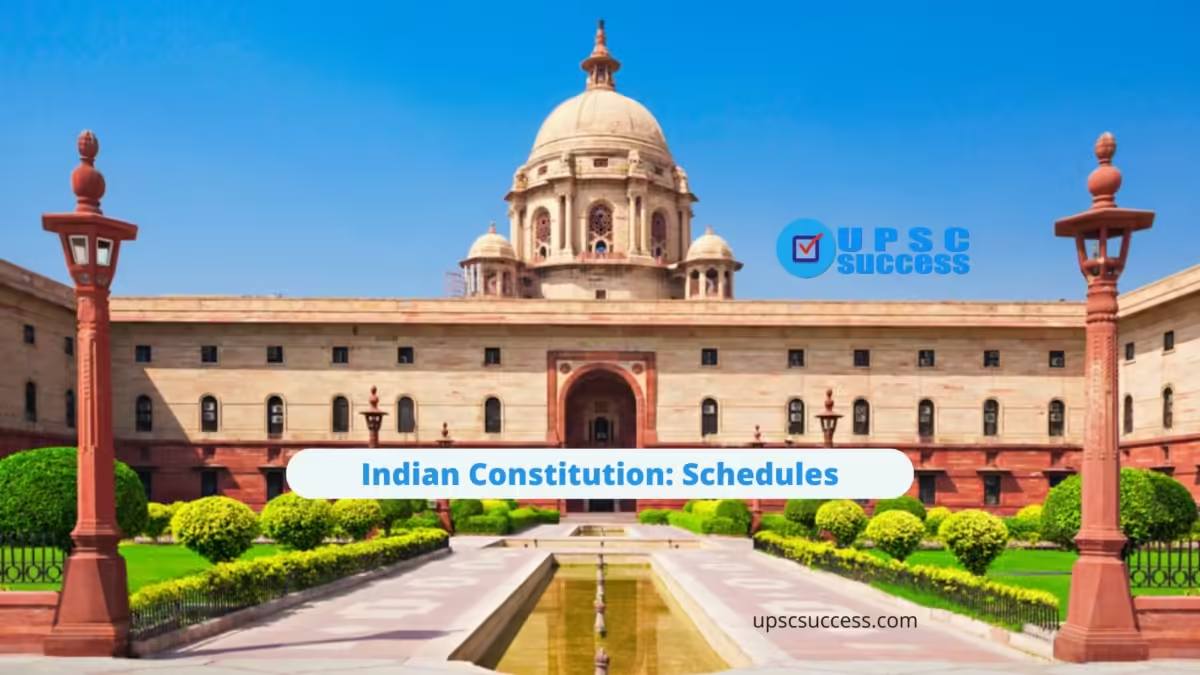Contents
The Indian Constitution isn’t just a bunch of long articles! It also has special sections called Schedules that contain important details. Think of them like bonus info sheets that explain things in more detail. These Schedules aren’t fancy or complicated, but they’re crucial for understanding how the Constitution actually works.
Schedules are an integral part of the Indian Constitution which have details that are not mentioned in the articles. Original constitution consisted of 395 articles divided into 22 parts and 8 schedules)
Schedules were first mentioned in the Government of India Act,1935.
The original constitution only carried 8 schedules, while currently, we have 12 schedules after
amendments:
- Schedule IX- 1st Constitution Amendment Act, 1951
- Schedule X- 52nd Constitution Amendment Act, 1985
- Schedule XI- 73rd Constitution Amendment Act, 1992
- Schedule XII- 74th Constitution Amendment Act, 1992
Indian Constitution: Schedules
Schedules are lists in the Constitution that categorize and tabulate the bureaucratic activity and policy of the Government. The Indian Constitution originally had eight schedules. Four more schedules were added by different amendments, now making a total tally of twelve.
| Schedules | Description |
|---|---|
| First Schedule Articles 1 and 4 | I – The States. II. – The Union territories. Names of 28 states and 8 Union Territories and their territorial jurisdiction. |
| Second Schedule Articles 59(3), 65(3), 75(6), 97, 125, 148(3), 158(3), 164 (5), 186 and 221 | PART A: Provisions as to the President and the Governors of States. PART B – Repealed PART C – Provisions as to the Speaker and the Deputy Speaker of the House of the People and the Chairman and the Deputy Chairman of the Council of States and the Speaker and the Deputy Speaker of the Legislative Assembly and the Chairman and the Deputy Chairman of the Legislative Council of a State PART D – Provisions as to the Judges of the Supreme Court and of the High Courts. PART E – Provisions as to the Comptroller and Auditor-General of India. |
| Third Schedule Articles 75(4), 99, 124(6), 148(2), 164(3), 188 and 219 | Forms of Oath for office, Secrecy and Affirmation. – Union and State ministers (Ministers take both the oath of office and oath of secrecy) – Candidates for election to the Parliament and State Legislature. – Members of Parliament and State legislature – Judges of the Supreme Court and High Courts – Comptroller and Auditor General of India |
| Fourth Schedule Articles 4(1) and 80(2) | Allocation of seats in the Council of States. |
| Fifth Schedule Article 244(1) | Provisions as to the Administration and Control of Scheduled Areas and Scheduled TribesPART A – General. PART B – Administration and Control of Scheduled Areas and Scheduled Tribes. PART C – Scheduled Areas. PART D – Amendment of the Schedule. |
| Sixth Schedule Articles 244(2) and 275(1) | Provisions as to the Administration of Tribal Areas in the States of Assam, Meghalaya, Tripura and Mizoram. |
| Seventh Schedule Article 246 | List I – Union List. List II – State List. List III – Concurrent List. |
| Eighth Schedule Articles 344 (1) and 351 | List of Recognised Languages |
| Ninth Schedule Article 31B | Validation of certain Acts and Regulations. |
| Tenth Schedule Articles 102(2) and 191(2) | Provisions as to disqualification on ground of defection. |
| Eleventh Schedule Article 243G | Powers, authority and responsibilities of Panchayats. |
| Twelfth Schedule Article 243W | Powers, authority and responsibilities of Municipalities, etc. |

Shortcut to remember all 12 Schedules of the Indian Constitution
‘TEARS OF OLD PM’
- T – Territory
- E – Emoluments
- A – Affirmation/Oaths
- R – Rajya Sabha
- S – Scheduled Areas
- O – Other Scheduled Areas
- F – Federal Provisions (3 lists)
- O – Official Languages
- L – Land reforms
- D – Defection
- P – Panchayats
- M – Municipalities
Fifth Schedule
The 10 States of Andhra Pradesh, Chhattisgarh, Gujarat, Himachal Pradesh, Jharkhand, Madhya Pradesh, Maharashtra, Odisha, Rajasthan and Telangana have Fifth Schedule Areas.
Article 339: The President appoints a Commission for SA. (Dhebhar Commission (1960) and
D.S Bhuria Commission (2002))
Criteria for Declaration of any area as Scheduled Area (Dhebar Commission)
- Preponderance of tribal population
- Compactness and reasonable size of the area,
- Viable administrative entity such as a district, block or taluk.
- Economic backwardness of the area as compared to the neighbouring areas.
Provisions:
- President declare SA + increase/decrease area, alter boundary, redefine area (in consultation with Governor)
- Executive power of the State extends to these areas + Centre executive power
- Giving directions to the State for administration of SA
- Tribes Advisory Council: setup in SA & also where significant tribe(if president directs) + max 20 members (¾ ST representative in SLA) + Governor may make rules Regarding the number of Council Members, appointment of chairman etc.
- Governor has enormous legislative powers: Submit report annually to President + can direct that any particular act of Parliament or legislature does not apply to SA or apply with modification.
- Governor + TAC (with President Assent): may make regulations to restrict or prohibit transfer of land + allotment of land + moneylending + repeal or amend Parliament/Legislature Act.
- Fifth Schedule Areas are exempt from the Panchayat-related requirements of Part IX of the constitution. PESA Act, 1996, was passed to extend provisions of Part IX to the fifth Scheduled area.
Provisions in the Fifth Schedule may be amended, altered, or repealed by Parliament (but not under Ar 368)
Sixth Schedule
To govern the tribal areas of Assam, Meghalaya, Tripura and Mizoram.
Provisions:
- Tribal areas to be administered as Autonomous Districts(AD) + If different ST in autonomous district. Governor can divide district inhabited by them into Autonomous Regions(AR)
- Governor: organise/reorganise/increase/decrease the boundaries/alter name of autonomous district.
- Parliament or Legislature Act do not apply or apply with modifications in AD & AR.
- District Councils (for AD) and Regional Councils(for AR)
- District Council: Max 30 Members → 26(Elected) + 4(Nominated by Governor)
- With Governor’s assent – can make laws on lands, forest management (except Reserved Forest), inheritance of property, and money-lending.
- DC & RC can constitute Village and District Council Courts → HC & SC has further jurisdiction.
- DC & RC can collect land revenue; impose taxes; and grant licences for the extraction of minerals.
- DC & RC can manage primary schools, dispensaries, markets, roads, ponds etc.
- Governor appoints commission.
- Area ⇒ 3+3+3+1 (1) in Tripura
| State | Area |
|---|---|
| Assam (3) | North Cachar Hills District Karbi Anglong District Bodoland Territorial Areas District |
| Tripura (1) | Tripura Tribal Areas District |
| Meghalaya (3) | Garo Hills District Khasi Hills District Jaintia Hills District |
| Mizoram (3) | Chakma District Mara District Lai District |
Indian Constitution:

